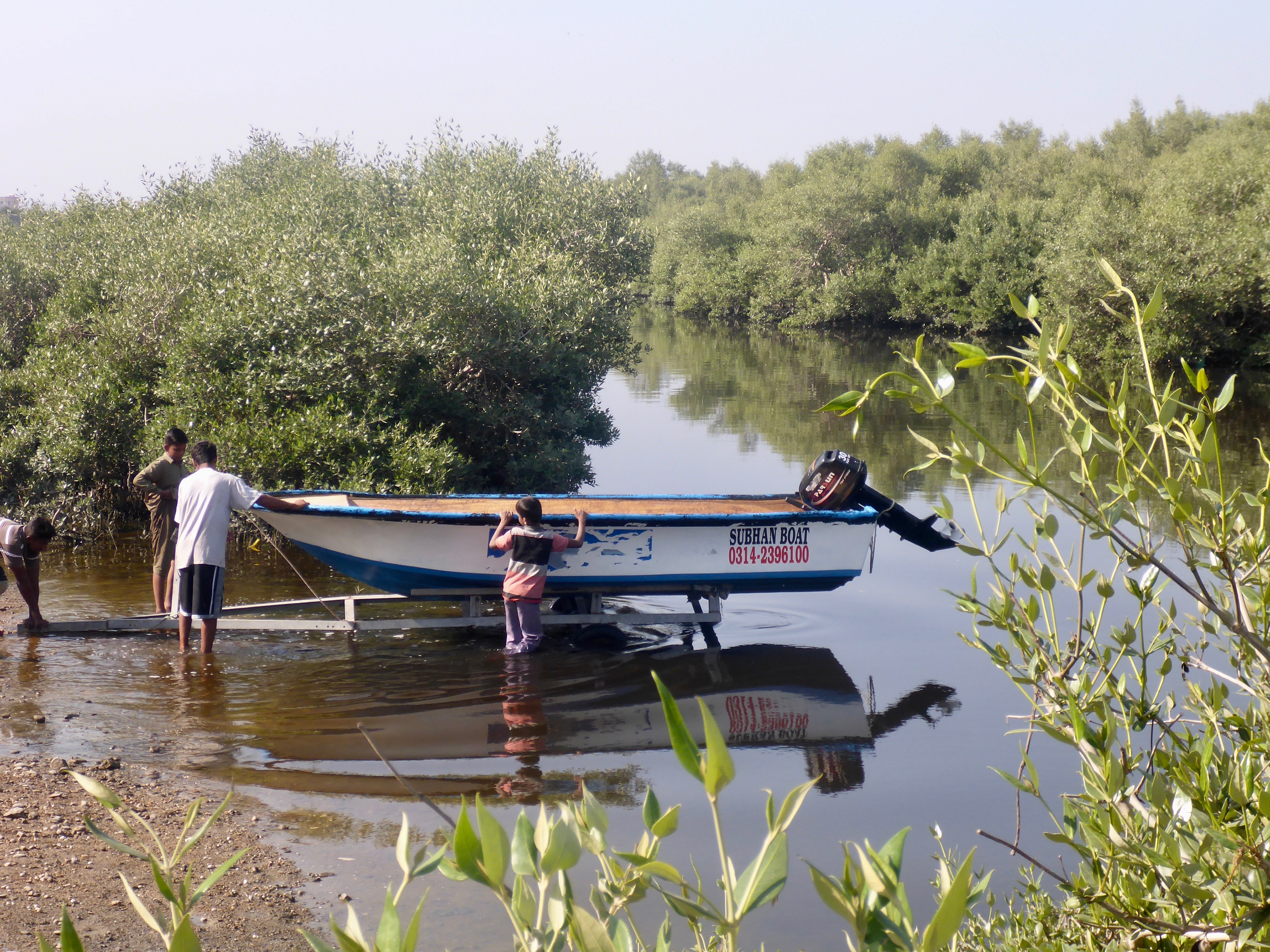Pakistan
Pakistan’s Challenges to Political Stability and Economic Revival

Sandspit Wetlands, Near Liyari, Karachi Nov 2021 Birgit Lamm
© Birgit Lamm/ Friedrich Naumann Foundation for FreedomPakistan has probably seen a negative GDP growth rate in 2022-23 due to the floods and shortages of imported inputs. Today, Pakistan is also experiencing an unprecedented rate of inflation of over 28% during the last three months, with even higher food inflation of 41%.
Consequently, we are witnessing the worst over ‘stagflation’. The investment level has plummeted to 11.9% of the GDP in 2022-23 from 14% of the GDP in 2021-22. It is probably the lowest ever.
The economy has also been passing through cycles of external vulnerability, especially with imports sometimes peaking at over three times the exports. At the start of the current financial year, the foreign exchange reserves of the SBP were only $4.5 billion, not even adequate to provide import cover for one month.
Consequently, the rupee has depreciated by over 81% in the last two years. The total external debt now stands at close to $128 billion, equivalent to almost 43% of the GDP. External debt has doubled in only the last eight years. The external financing requirements, net of likely rollovers, are likely to cumulatively exceed $55 billion from 2023-24 to 2025-26. Pakistan has recently entered a nine-month Stand-by Facility of $3 billion with the IMF. A three-year Extended Fund Facility will probably be required afterwards.
The budgetary position of the Federal and Provincial Governments has worsened over the years. Five years ago, the budget deficit was 5.8% of the GDP. It rose to 7.7% of the GDP last year. This has also put pressure on the trade deficit due to the impact on aggregate demand.
Today, Pakistan is also experiencing an unprecedented rate of inflation of over 28% during the last three months, with even higher food inflation of 41%.
The tax-to-GDP ratio has fallen from 11.4% of the GDP in 2017-18 to 9.2% of the GDP in 2022-23. Meanwhile, the total current expenditure to GDP ratio has jumped up from 14.9% of the GDP to 17.2% of the GDP, especially on debt servicing. Development spending has plummeted to 2.3% of the GDP from 4.1% of the GDP. Public debt now stands at 74.3% of the GDP as compared to 60% seven years ago.
Last year, there was a clear manifestation of the financial crisis in the form of net federal revenue receipts becoming less than the cost alone of debt servicing. Consequently, the entire defense budget, subsidies, grants, salaries, and pensions, etc., have all been financed by borrowing. Clearly, this is an unsustainable position and especially in the presence of an IMF Program there will be strong pressure to contain these expenditures so as to generate a primary surplus.
Simultaneously, there has been high income inequality. According to the World Inequality Report of 2022, the top 10% of the population of Pakistan pre-empted 44% of the national income in 2022, while the bottom 50% have a share of only 16%, implying a per capita income ratio of 14:1. Inequality has also been increasing over the years, especially during the tenures of military regimes. Also, the top 10% possess 60% of the country’s wealth.
The result of stagflation, rapidly increasing food prices, and high and growing inequality is that there has been an exponential increase in the level of unemployment and in the number of poor. The unemployment rate has jumped up from 6.9% in 2018-19 to over 9.5% in 2022-23. Over 7 million workers are unemployed today. Real wages have fallen by over 20% in the last two years. There are also now over 20 million ‘idle youth’, many of whom are likely to resort to crime, totalitarianism, and vandalism.
The incidence of poverty was 34% in 2018-19. It is estimated to have increased to 46% by 2022-23. During these four years, the number of poor has jumped up by 39 million to 111 million. The ‘poverty gap ‘now stands at over Rs 2200 billion, over four times the proposed cash transfers under the BISP.
Overall, there is no doubt that Pakistan is neck deep in a financial crisis today. The life blood of the economy is in revenues and exports, once again revenues and exports. The remainder of my talk will focus on the strategy for raising government revenues.
The national collection by the Provincial Governments from the agricultural income tax is a paltry PKR 03 billion (~ 9.5 mil EUR). If income tax rates on the agricultural income taxpayers were the same as on personal income taxpayers the revenue would have been close to Rs 225 billion (~718 million EUR)
MOBILIZATION OF REVENUES
The tax system of Pakistan is not progressive today. Over 74% of the revenues are indirect in nature, including some withholding income tax levies. Also, the distribution of the tax system amongst sectors is very uneven in terms of the level of incidence, as shown below:
The tax burden is:
- 37% of the Value Added in the Industrial Sector.
- 4% of the Value Added in the Services Sector, low especially in the Wholesale and Retail Trade and Real Estate sectors.
- 1% of the Value Added in the Agricultural Sector.
with the overall tax incidence in the economy at under 10% of the GDP.
Also, despite the fiscal powers to access large sectors like services and agriculture, Provincial Governments generate only 8% of the national tax revenues.
the top 10% of the population of Pakistan pre-empted 44% of the national income in 2022, while the bottom 50% have a share of only 16%, implying a per capita income ratio of 14:1
Observations from the UNDP Human Development Report on Pakistan
There is a need to highlight the findings of the UNDP Human Development Report on Pakistan of 2020-21. This report is on Inequality with focus on
‘Power, Policy, People’
The report highlights the extent to which the tax system of Pakistan has been captured by the elite of the country consisting of the following:
- The feudal class, big corporate entities, high net worth persons, large traders, real estate owners and developers, the military establishment, etc.,
They are able to influence the political process and play a major role in the formulation and implementation of fiscal and other policies.
This has resulted in wide ranging direct tax exemptions, concessions, rebates, low nominal or effective tax rates and high levels of tax evasion with the connivance of the tax authorities.
The UNDP report estimates the loss in revenues at over 2.5% of the GDP due to these tax benefits to the elite, equivalent to Rs 2600 billion today.
Some stellar examples include the following:
- The national collection by the Provincial Governments from the agricultural income tax is a paltry Rs 3 billion. If income tax rates on the agricultural income taxpayers were the same as on personal income taxpayers the revenue would have been close to Rs 225 billion, given the extreme inequality in the distribution of farm area. 1% of the farmers own 22% of the farmland.
- The total collection from diverse federal and provincial taxes on property/real estate is Rs 160 billion, whereas the potential revenue can be almost four times higher at Rs 600 billion.
- The tax evasion in the wholesale and retail trade sector is currently over Rs 160 billion.
The withholding tax regime in income tax has been converted into a fixed and final tax system. This has largely eliminated the progressivity. The time has come for a reversion to an advanced tax regime, with the individual taxpayer expected to file his/her tax declaration with both the earned and unearned income and the income tax rates applied on total income.
Some very candid observations
Let me describe my experience with a two-hour presentation of the detailed Agenda of Reforms to the then Prime Minister three years ago, with many of the cabinet ministers present. As I was leaving the meeting, my assistant informed me that the Prime Minister had said ‘very good’ 41 times to specific reforms. But when the federal budget was presented some months later, not even one of the progressive tax reforms was included. This clearly demonstrates the power of the elite to pre-empt the process of resource mobilization through progressive tax reforms.
Hopefully, the time has come when in the larger self-interest or in the face of a social meltdown a consensus will be reached at the highest level on a progressive agenda of tax reforms for implementation on a top priority basis. Combined with a radical program of curtailment of current expenditures Pakistan will be able to restore the viability of public finances and achieve a quantum reduction in the public debt burden. Enough fiscal space will be created to provide significant relief to the larger number of poor in Pakistan today.
The Pakistani rupee has depreciated by over 81% in the last 02 years, while external debt has doubled in the last 08 years.
Charter of Economy
The detailed tax reform proposals have been presented in my book on Charter of the Economy, which was published in 2021 and is available on Google search. It also includes proposals for rightsizing of the Federal Government, promoting exports and managing the balance of payments. Copies of the book were made available to the President and leaders of the major political parties. However, there was no response.
Below are the recommendations and proposals for Mobilizing Revenues Through Progressive Taxation
FEDERAL
The following proposals for progressive taxation may be implemented:
- Higher return on equity of companies above 15% to be taxed at the rate of 37.5%. For banking companies, the corporate tax rate should be 45%.
- Conversion of fixed and final taxes on dividends, interest income on bank deposits, etc., into advance taxes and merger of such income into total taxable income. Merger also of rental income into total income for tax purposes.
- Minimum tax on capital gains from land or property sales of 10% irrespective of the holding period.
- Levy of advance tax on share transactions of 1%.
- Levy of income tax on pensions above Rs 1,500,000 annual income at half the rate of the personal income tax.
- The tax credit for investment in shares, life and health insurance should be at 15%, irrespective of the size of the taxpayer, with no carryover.
- The share of credit extended by commercial banks to the socially preferred sectors including agriculture, SMEs, micro finance, and infrastructure is only 12%. As an incentive, for any bank credit above 20% combined to these sectors of the total credit, a 5% tax credit to be offered on the extra amount.
- Expansion of the withholding tax on electricity bills of traders, with greater progressivity. Setting up a system of reporting of sales invoices by big retailers.
- Introduction of an Inheritance Tax at 2% to 10%.
PROVINCIAL
- Development of the Agricultural Income Tax. This tax can be a very progressive tax given the highly unequal distribution of farm area in the country. The flat rates which increase with farm area should be substantially enhanced.
- The property tax is also very underdeveloped. It should be the primary source of revenue to urban local governments. This will require substantial updating of the gross annual rental values for tax purposes based on rental / property value surveys at the locality in all cities with population exceeding 1 million.. It will also be a very progressive tax.
- Levy of a Capital Value Tax on property at 0.5% to 2.5% above a minimum value.
The above text was originally intended to be shared as Key Note speech by Dr. Hafiz A. Pasha during FNF /CPDI/PRIME institute Conference on “Pakistan’s Challenges to Political Stability and Economic Revival” on 2nd October 2023. Dr. Pasha was unable to deliver the keynote , however, he graciously allowed us to share the text with minor edits as website article.
